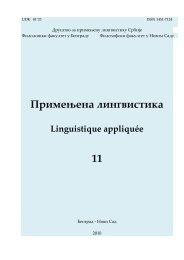Примењена лингвистика у част Ранку Бугарском - Језик у
Примењена лингвистика у част Ранку Бугарском - Језик у
Примењена лингвистика у част Ранку Бугарском - Језик у
You also want an ePaper? Increase the reach of your titles
YUMPU automatically turns print PDFs into web optimized ePapers that Google loves.
Victor A. Friedman: FROM THE BALKANS TO BAHASA: COMPARATIVE ...<br />
that does not usually spring to mind, but that is well worthy of future research,<br />
namely some of the language situations in Southeast Asia – especially the Malayo-Indonesian<br />
region, which I term the Bahasa region (see below) – that can<br />
fruitfully be compared to Southeast Europe.<br />
In a sense Southeast Europe and Southeast Asia represent the two tips of an<br />
Islamic crescent: the Balkans at the northwest and Malaysia and Indonesia at the<br />
southeast, and this fact helps bring out linguistic comparisons not usually made. 1<br />
An anecdote that relates to Macedonia and Malaysia, or, more exactly, to Macedonian<br />
and Malay, can serve as an introduction. I was in Skopje in 2009, corresponding<br />
by e-mail with James Collins, director of Northern Illinois University’s<br />
Center for Southeast Asian Studies, and at the time I was counseling patience. I<br />
used the old-fashioned Macedonian expression sabar. It is no coincidence that<br />
this is exactly the same word in Malay. The word is from the Arabic root ṣabr, it<br />
was brought to both Southeast Europe and Southeast Asia via Islam (via Arabic<br />
and Turkish, respectively), and it denotes an Islamic cultural value – ultimately,<br />
the qualities of endurance and acceptance – that finds resonance in the day-to-day<br />
lives of many peoples of many religions and becomes adopted as local or perhaps<br />
is even laminated onto that which is already local.<br />
Beg’s (1979) comparative study of Arabic loanwords in Malay and other<br />
languages highlights the need for more comparison of Southeast Europe and<br />
Southeast Asia by his very lack of such material. Beg gives an interesting compilation<br />
of Arabic loanwords that occur in Malay, on the one hand, and a comparison<br />
with a variety of African, Asian, and European languages, on the other. For<br />
Africa he has Hausa, Berber, Somali, Swahili, and seven languages of Ethiopia 2 ,<br />
for Asia he has five Indic languages 3 plus Tibetan, 4 and for Europe English, Latin,<br />
and Spanish with passing mention of three other Romance languages 5 as well as<br />
Turkish (p. xvi). Beg’s (1979: xvi) sample of ten words of Arabic origin shared by<br />
Turkish, Swahili, and Malay, is illustrative of the impact of Arabic on the Balkans<br />
via Turkish: every single one of these words also occurs in Bulgarian, Macedo-<br />
1<br />
To be sure, North Africa (and formerly Spain) extend further west, Western Europe is now grappling<br />
with a new set of contacts with Islam, and in the east China and the Philippines both have significant<br />
populations. Still, in terms of the combination of historical spread and large-scale national<br />
Islamization, the Balkans are the northwesternmost and Malaysia-Indonesia the southeasternmost<br />
tips, and the area from Anatolia to Arabia to Central Asia (sensu largo, including the relevant Indo-<br />
Iranian cultural area) forms a larger historical and geographic center.<br />
2<br />
Geez, Harari, Amharic, Argobba, Gurage, Tigre, Tigrinya.<br />
3<br />
Hindi, Gujarati, Pahari, Bengali, Oriya.<br />
4<br />
Note especially bag-šiš ‘tip’, bi-ṣli-mli ‘great demon’, hu-ka ‘water pipe’, ’a-rág ‘barley-based<br />
alcoholic beverage’<br />
5<br />
French, Italian, and Portuguese.<br />
56




